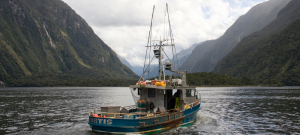As one of the most southern group of islands in the Pacific Ocean, New Zealand is a hot-spot for marine life. Each year, fantastic combinations of migratory species seasonally grace its waters, such as blue, humpback and sperm whales and, of course, tuna.
Summer in New Zealand means albacore season. As the weather begins to warm in mid-November, the troll tuna fishery that operates off the western coasts of the North and South Islands of New Zealand comes to life.
 The New Zealand troll tuna fishery is made up of approximately 150 vessels that are around 12-24m in length. Each vessel, operated by a crew of around 2-5 fishers, voyages out to the tuna fishing grounds located approximately 10-15 nautical miles offshore for trips that last between 2-5 days.
The New Zealand troll tuna fishery is made up of approximately 150 vessels that are around 12-24m in length. Each vessel, operated by a crew of around 2-5 fishers, voyages out to the tuna fishing grounds located approximately 10-15 nautical miles offshore for trips that last between 2-5 days.
Troll fishing, like pole-and-line and handline fishing, catches tuna one-at-a-time, and uses unbaited lures. In this practise, multiple lines are drawn through the water behind a moving vessel. Once a tuna has been hooked, fishers pull in the line and unhook the catch before setting the line back in the water. The troll fishery catches albacore, typically 5-8 kg and 60-70 cm in size.
The albacore are kept chilled on ice aboard the vessels and once landed are exported in whole, frozen form to countries for processing into loins, canned and jarred products, and then distributed for markets in Thailand, Vietnam, the Philippines and France.
Annually, this fishery catches around 2,500-3,300 tonnes of south Pacific albacore. Albacore comprises over 97 percent of the catch, making it an extremely environmentally friendly fishery. Of the non-albacore catch, a major component is skipjack tuna (2.1%) which is also sold and exported. Like other one-by-one fisheries, no endangered, threatened or protected species are impacted.
The New Zealand troll tuna fishery promotes one of the cleanest and greenest ways to catch tuna, supporting coastal communities and healthy oceans in the South Pacific. The fishery was certified by the Marine Stewardship Council in 2011, a process that was spearheaded by IPNLF Member the New Zealand Tuna Management Association, and recertified in 2017.